1.4 Deployment and Implementation
To successfully deploy and implement an institutional repository, certain planning needs to be done. The following provides a guideline on typical processes and documentation that needs to be in place, although the requirements might differ from one institution to another.
1.4.1 Needs assessment (analysis)
To have a comprehensive understanding of the current practices, expectations and needs of a research community and the level of importance of the various needs, a thorough needs analysis has to be conducted. This needs analysis can be in the form of a checklist. Individual researchers can be interviewed, or groups of researchers. Also take into account the overall needs and strategy of the institution. The LEADIRS Workbook22 by Barton and Waters (2004, p. 52 – 56) contains an example needs assessment with sample questions, which can be customised and used as supplement to survey an institutions’ researchers about institutional repository plans. Below the sample needs assessment adapted from the LEADIRS Workbook by Barton and Waters (2004, p. 52 – 56).
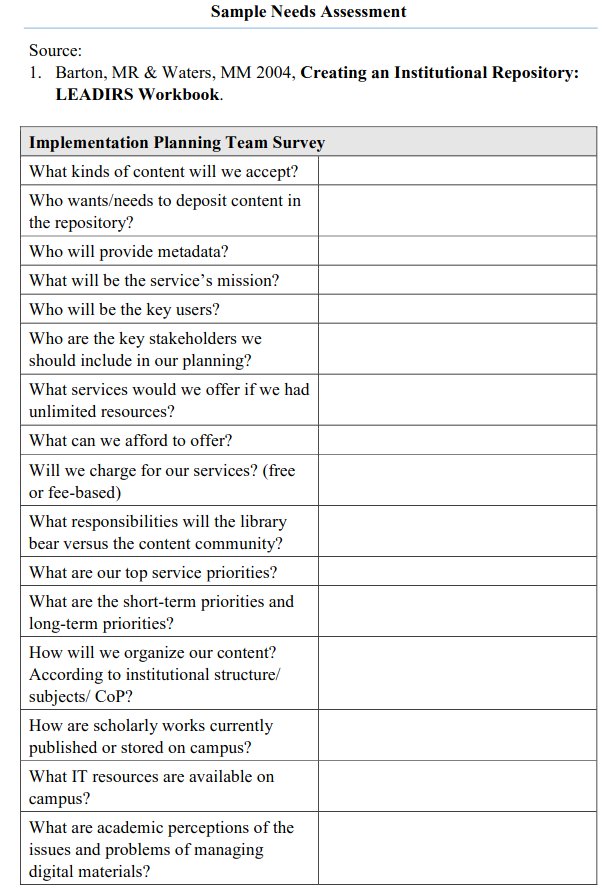
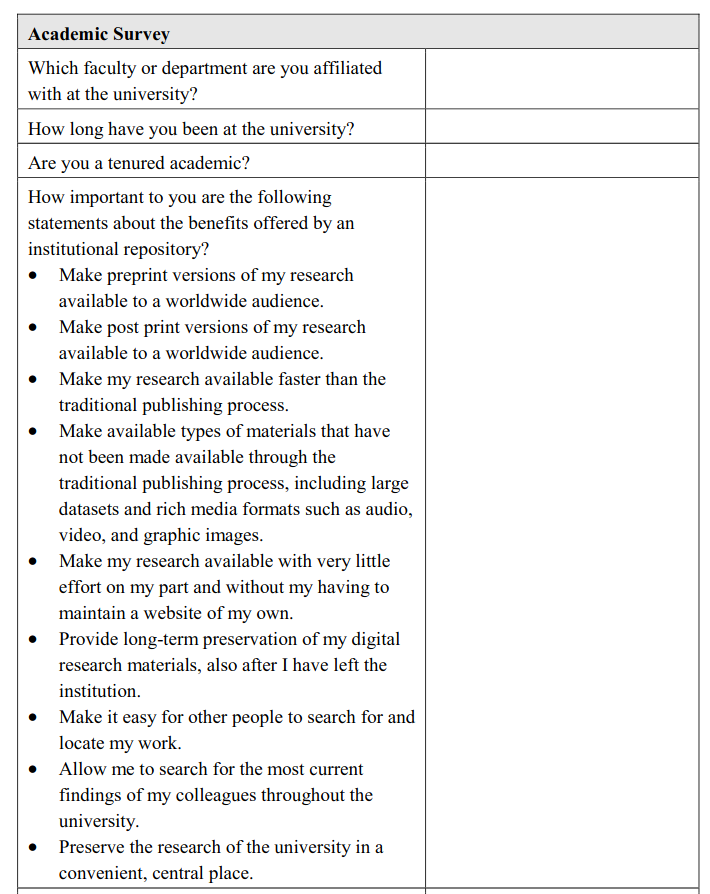
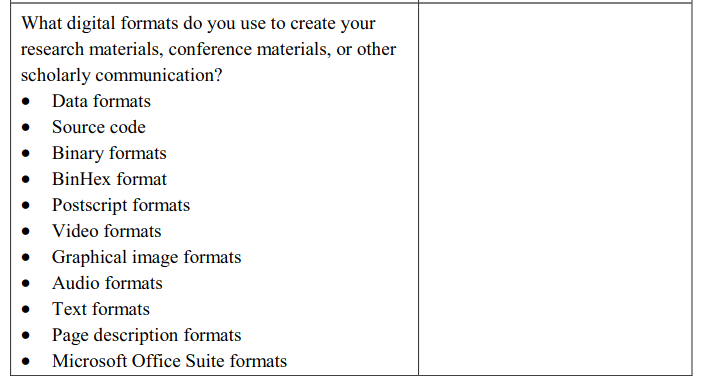
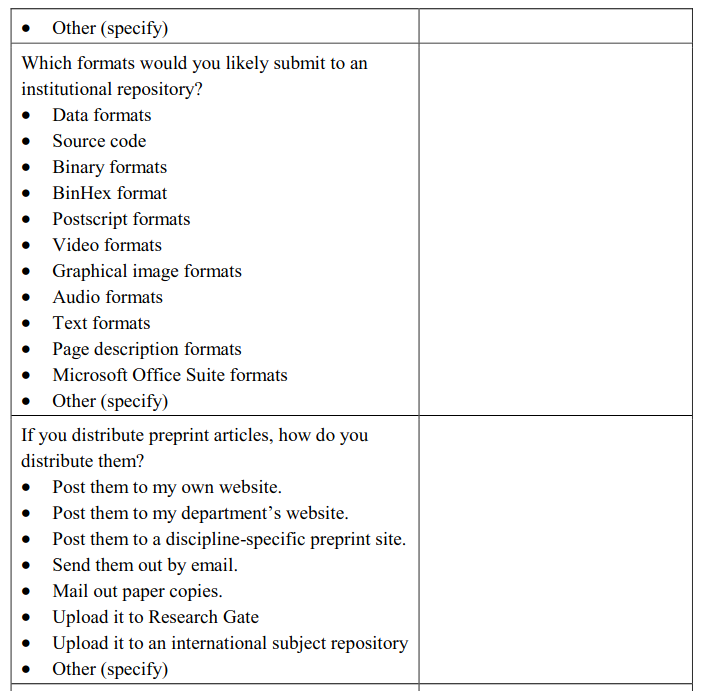
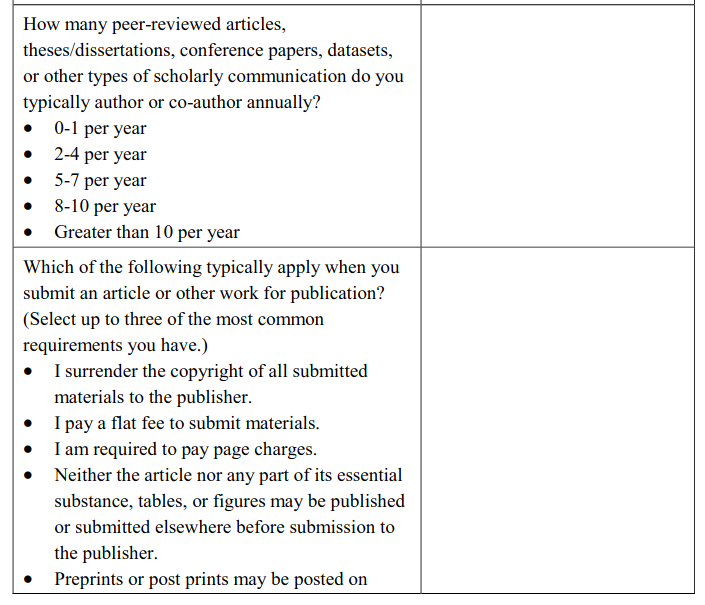
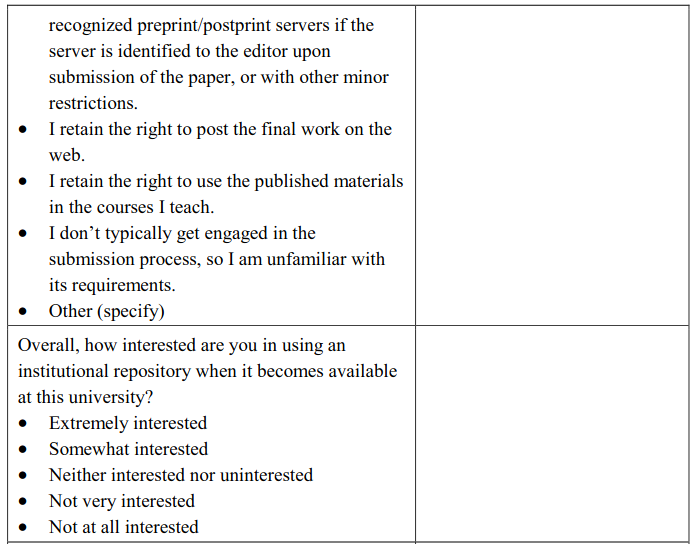
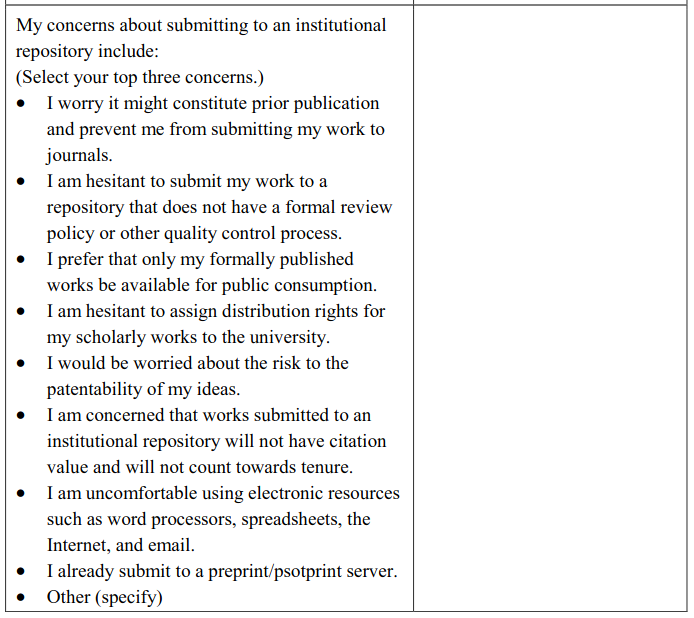
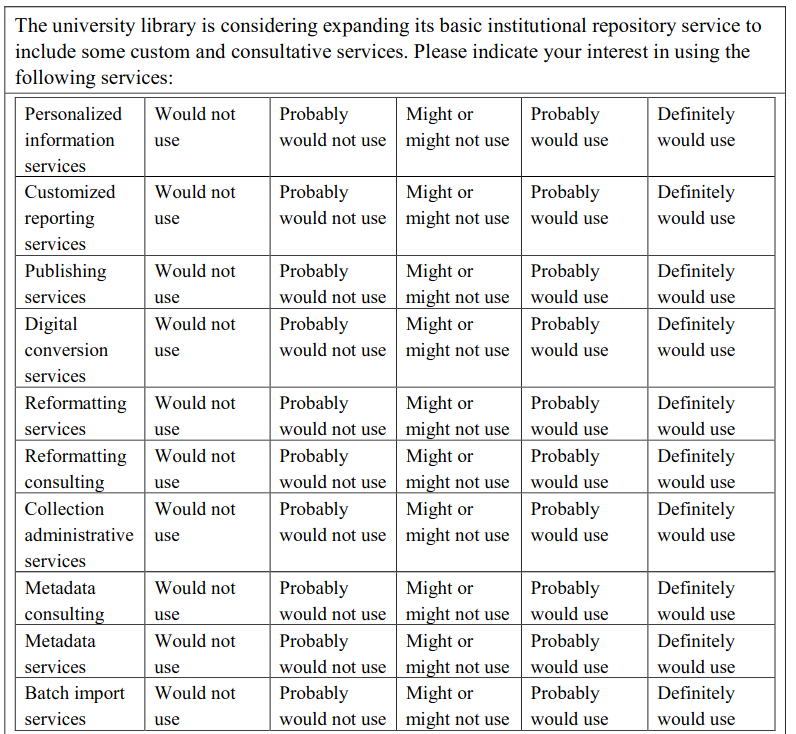
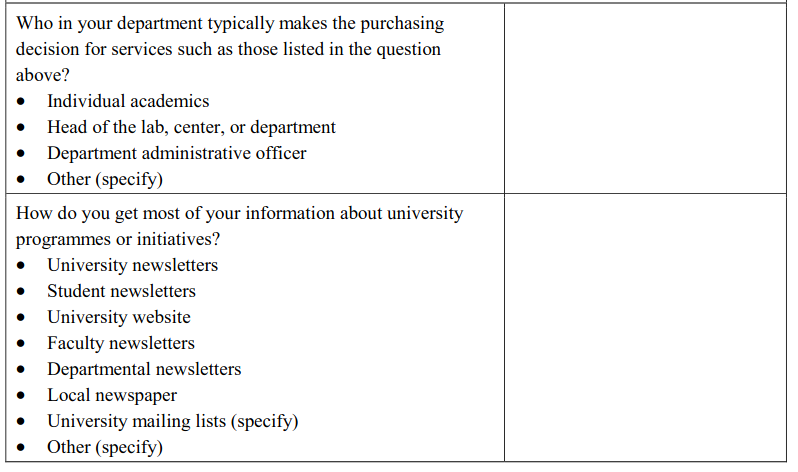
1.4.2 Business Case (Plan)
Once a need for an institutional repository has been established, and what it is researchers might expect from it, the service needs to be described. According to the Open Access Scholarly Information Sourcebook (Swan & Chan, 2009), the case for a repository must be made to the institution or community that will own and sustain it. In justifying a repository it is critical to work out a case that best aligns with the priorities of the institution. For research-based institutions this means focusing on the benefits to the institution in having a tool that can increase the usage and impact of its research effort, maximise the visibility of its outputs and provide a management information system for monitoring and assessing the research carried out in the institution. In countries that have a formal national research assessment scheme, institutional repositories will be a boon to collecting data and compiling returns and a case can be made based on this issue. A carefully prepared case to senior management will highlight the appropriate advantages of the repository to the institution, will detail expected expenditure over a number of years, and will emphasise that the payoff is not measured in financial terms. Please be advised that the following business plan is a sample only, and that it needs to be updated with the most recent information from time to time. Where indicated, please provide own text.
Sample Business Plan (Business Case)
Cover Page(to be compiled) Document History Page(to be compiled)Contents Page(to be compiled) Executive Summary The University of X institutional repository is a Library and Information Service initiative. The library has identified the successful implementation of this repository as part of its objectives in its strategic plan for the period 2010 to 2015. This library strategic plan has been aligned with the overall University of X strategy, and the repository will contribute to the library supporting the University’s research strategy. According to Lynch (2003) an institutional repository offers a set of services to the members of a community (University of X Community), for the management and dissemination of digital academic/research materials (excluding work of administrative or commercial nature, work in progress) donated to or created by the institution and its community members. The set of services includes the collection, storage and preservation in digital format, and retrieval of items submitted to the institutional repository. In addition to centrally preserve all intellectual output by researchers at the University, this repository will also help improve the visibility, usage and impact of research conducted by University of X researchers on the world out there. DSpaceTMopen source software will be used for the implementation of this repository. The Director: Information Technology and Communication is responsible for the development and implementation of the library strategy, including the institutional repository. The Institutional Repository Manager and the Institutional Repository Systems Engineer will be responsible for the research, development, implementation and maintenance of the institutional repository.
1. ABOUT THE UNIVERSITY OF X
Being an internationally recognised teaching, learning and research intensive university is central to the University of X’s strategic plan. The University is currently considered to be one of the leading institutions of higher education in the country. The mission of the University of X is to create and sustain an environment in which knowledge can be generated, shared and applied to the benefit of the community. According to Prof. X, Vice-Rector (Research) an essential part of this mission is underpinned by the research activities of the University. The output of research at the University of X enriches the body of knowledge, informs the content of the curriculum and provides the scientific basis for novel applications and services that benefit the wider community. In the annual report for 2008 Prof. X stresses that research output also helps to support the vision of the University in its endeavour to be an academic institution of excellence by contributing towards the building of the scientific, technological and intellectual capacity of Africa and by being an active role player in the development of the South African society. To further strengthen its position as a premier research institution and to ensure future success, the University of X aligned the research activities with the key development themes to which the University has committed itself. Within the research community it has been recognised that the following themes provide a broad framework for structuring research activities:
- Consolidating democracy and ensuring regional peace and security.
- Eradicating endemic poverty.
- Contributing to human dignity and health.
- Ensuring environmental and resource sustainability.
- Maintaining the competitiveness of industry.
The research activities clustered in this broad framework are informed by a solid foundation of fundamental scientific research. The Library and Information Service is one of four divisions that help provide an overarching institutional service to the research community at the University (Prof. X, 2008).
1.2 LIBRARY AND INFORMATION SERVICE
According to the 2008 annual report of the University, the library provides an essential service to the research community of the University of X. Recognition of the library’s central role and pivotal importance in academic success was affirmed with the approval of the Overarching Strategic Plan project Access to Electronic Resources (Prof. X, 2008). The library has as its core function the provision of a range of support services and products aimed at promoting research through the support of the individuals who carry it out. A number of strategic actions and plans were identified for 2010, one strategic goal being that of “Support, develop and contribute to high-level scholarly publication output”. The main action to achieve the above strategic objective is the establishment of an e-Repository Research system (for primary data, research output, Open-Access publication-based content, digitized special collections, and rich media content types) to ingest, preserve and disseminate the intellectual output of the institution. The following action plans need to be conducted to achieve the above mentioned strategic goal:
1)Map the institutional digital landscape by:
- conducting a campus-wide audit of existing digital collections, resources, potential projects and services;
- identify analogue materials that may need to be converted to digital format.
2)Implement digital services and programs by:
- establishing
library-based service procedures and workflows;
- establishing
internal and external partnerships.
3)Establish protocols and policy for
the preservation of digital assets.
4)Market the repository and provide
outreach and education.
5)Develop an assessment and evaluation plan which will enable user feedback on the system and system content.
Achievements of the previous library strategy include the following:
1)Mandatory policy for the online submission of all theses and dissertations.
2)Implementation of a workflow between the Library and the Office of the Registrar.
Governance
- The Director: Information Technology and Communicationis responsible for the development and implementation of the strategy and the repository (Dr X).
- The Institutional Repository Manager (X) and the Institutional Repository Systems Engineer (X) are responsible for the research, development, implementation & maintenance of the repository system.
2. AN INSTITUTIONAL REPOSITORY SERVICE FOR THE UNIVERSITY OF X
2.1 ABOUT INSTITUTIONAL REPOSITORIES
More and more institutions worldwide are starting to implement digital institutional repositories to capture, store, index, preserve and redistribute a university’s scholarly research in digital formats. Scholarly assets can include both digitally born and non-digitally born material of an organization. Currently there are approximately 3 500+ repositories internationally, of which3 565 on the Registry of Open Access Repositories (ROAR at http://roar.eprints.org/), 2 527 on openDOAR (http://www.opendoar.org/) and 1 650 ranked by Webometrics (http://repositories.webometrics.info/en/world). Of these X are in (to be completed)country. A digital repository offers many advantages. In addition to preserving intellectual output in digital format for years to come, it can also help improve the visibility, usage and impact of research conducted at an institution worldwide. According to Lynch (2003) an institutional repository offers a set of services to the members of a community (X Community), for the management and dissemination of digital academic/research materials (excluding work of administrative or commercial nature) donated to or created by the institution and its community members. The set of services includes the collection, storage and preservation in digital format, and retrieval of items submitted to the institutional repository. “It is most essentially an organizational commitment to the stewardship of these digital research materials, including long-term preservation where appropriate, as well as organization and access or distribution” (Lynch 2003).
Universities and research libraries around the world use institutional repositories in many ways (Barton & Waters 2005):
- Scholarly communication
- Storing learning materials and courseware
- Electronic publishing
- Managing collections of research documents
- Preserving digital materials for the long term
- Adding to the university’s prestige by showcasing its academic research
- Institutional leadership role for the library
- Knowledge management
- Research assessment
- Encouraging Open Access to scholarly research
- Housing digitized collections
2.2 ABOUT DSPACE
DSpace(http://www.dspace.org ) software will be used to implement the University of X repository, developed at MIT with support from Hewlett Packard and now supported by DuraSpace, which complies with the Open Archives Initiative (OAI); thus allowing articles to be easily discovered by web search engines, services and indexing tools. The decision for using DSpace was made by the Library Management Team, under leadership of Dr X. Important role players that were involved in the decision-making process were:
- DrX (Senior Director: Library and Information Service)
- Dr X (Director: Information Technology and Communication)
- Mr X (Head: Library IT Division)
It was therefore a management decision. The decision to use DSpace was based on the following:
- The software complied with University of X functional requirements.
- The software complied with University of X technical architectural requirements.
- The DSpace interface provides for easy decentralised self-archiving by faculty, and organises the documents in logical, easily retrievable fashion.
- Each item in the repository will be assigned a unique persistent identifier, using the CNRI Handle System. The identifiers will be resolvable in perpetuity, and will remain valid even if content migrates to a new system. This allows documents in the repository to be properly and effectively cited in other research.
DSpace Availability:
- Free, open source software
- Latest version: DSpace3.2. Every effort will be made to utilise the most recent software releases to ensure continuity and long term access.
- Distributed through the BSD open source license.
- Download at http://www.dspace.org/latest-release.
DSpace Features: We decided on DSpace because of the following reasons:
- MIT designed the system in collaboration with the Hewlett-Packard Community between March 2000 and November 2002. It can therefore be regarded as highly reputable.
- The key aim of DSpace was and still is the long-term preservation of the intellectual output of researchers.
- It is easy to retrieve digital objects that have been submitted to DSpace.
- Regarding scalability – DSpace can handle large volumes of data.
- It also supports full text searching, provided that the full text were created electronically or were OCR’ed after being digitised.
- There is a good separation between data and metadata.
- DSpace supports the Open Archives Initiative.
- With open source the code is available to any programmer to change or adapt as he/she wishes.
- DSpace allows for easy integration into the existing University of X Portal.
- It has a well-defined workflow, automatically generates e-mails and forward tasks to different role players in the workflow process.
- It uses the Lucene Search Engine, which is a simple, high-performance, powerful search engine.
- The structure supports the participation of faculties, departments, research centers and other units typical of a large institution such as the University of X.
- It conforms to the technical and functional requirements set by our Dept. of IT.
- Our Dept. of IT supports the use of open source products.
- When accessing DSpace via the portal the user gets authenticated against the LDAP server, using his/her campus login credentials or e-mail address to verify and allow the user to submit items (after being registered as a Submitter for a specific Collection). Browsing is open to the rest of the WWW Community, and a user does not need to be authenticated to browse a Collection, except where access has been restricted to a selected group for reasons such as embargoes, confidentiality, patents.
- Distributed input from faculties and departments is possible and will be encouraged.
- Suitable platform for most academic digital objects.
- Quality control allows for review, editing and metadata editing of submitted items.
- Supports important metadata standards, e.g. Dublin Core.
- DSpace is OAI-PMH compliant.
- Java programming language is used.
- Metadata is stored in XML.
- Database used is PostgreSQL.
- Operating system used is Ubuntu 13.10.
- Security can be defined on various levels.
- A server is available at the University of X, Library and Information Service, IT Division.
- 1 000+ instances of DSpaceTMare currently running worldwide, making it the most popular platform for preserving digital material.
- Persistent identifiers are assigned to each item (CNRI handle system).
- DSpaceTM has the largest active community of users and developers worldwide.
A comprehensive evaluation has been conducted on open source institutional repositories funded by the JISC Foundation: Repositories Software Survey November 2010, online available (http://www.rsp.ac.uk/software/surveyresults ).
DSpace Technical support The following support is available:
- DSpace mailing lists
- LocalDSpace Community (X mailing list, hosted and maintained at the University of X, Library and Information Service)
- DSpace Wiki and Web Page (http://www.dspace.org/ )
- Regular conferences are held
- Bug Report System
- Dedicated programmers
- International support and expertise is well established. See http://dspace.org/service-providers
2.3 MOTIVATION FOR OPEN SOURCE SOFTWARE
From the literature it is clear that open source is gaining momentum amongst the higher education community nationally and internationally. “Open source software is also finding a home in the government arena. Following Cabinet's ratification of an open source strategy for South Africa earlier this year [i.e. 2005], a range of projects have been initiated by government, in particular the Department of Public Service and Administration (DPSA). For example the DPSA, together with the CSIR, earlier this year initiated a project to develop an open source corruption management system. Government also runs its wide area network using primarily open source software. The Centre for Public Service Innovation is also furthering the use of open source software through a number of projects designed to provide mobile access to government services in the under-serviced areas of the country. For a developing country like South Africa, OSS offers many benefits linked to social, economic, skills and business development.” (http://www.go-opensource.org/) The SA Government OSS strategy document is available at http://www.oss.gov.za/ The main reasons for using open source at the University of X are the following:
- It promotes collaboration and knowledge sharing between institutions who have the expertise, and the ones who do not have the expertise or necessary resources to start such a service. The University of X can contribute in this regard e.g. by hosting workshops and “scholar camps”.
- With open source software all participants benefit, and not only the vendor.
- The product belongs to all, and lots of support is available from the open source community.
- No marketing is involved – therefore there is not a clever salesman involved selling the product, only focusing on the stuff the program can do, and not the limitations.
- With open source, what you see is what you get.
- Open source software is flexible.
- It promotes openness and creative thinking.
- It is open for scrutiny.
- It is searchable and retrievable via the World Wide Web.
- It can be used by institutions with minimal resources.
- World standards and open standards are used, which makes it a very favorable choice. For long term sustainable support and digital preservation it is crucial that i) open systems based on open standards are used; ii) open digital formats based on open standards and formats/codecs are used; iii) formal relationships are established with support communities for open systems and software.
2.4 AN INSTITUTIONAL REPOSITORY FOR THE UNIVERSITY OF X
The institutional repository will be referred to as X, and will be a full text managed Open Access research repository. The purpose of X will be to offer a suite of services for the collection and management of the digital output of the University and its partnership communities. In the development of this repository, the Library and Information Service will commit itself to create a centralised forum for the collection, preservation and dissemination of the intellectual output and to share that intellectual output, provided that copyright has been cleared and the necessary permission has been obtained from copyright owners.
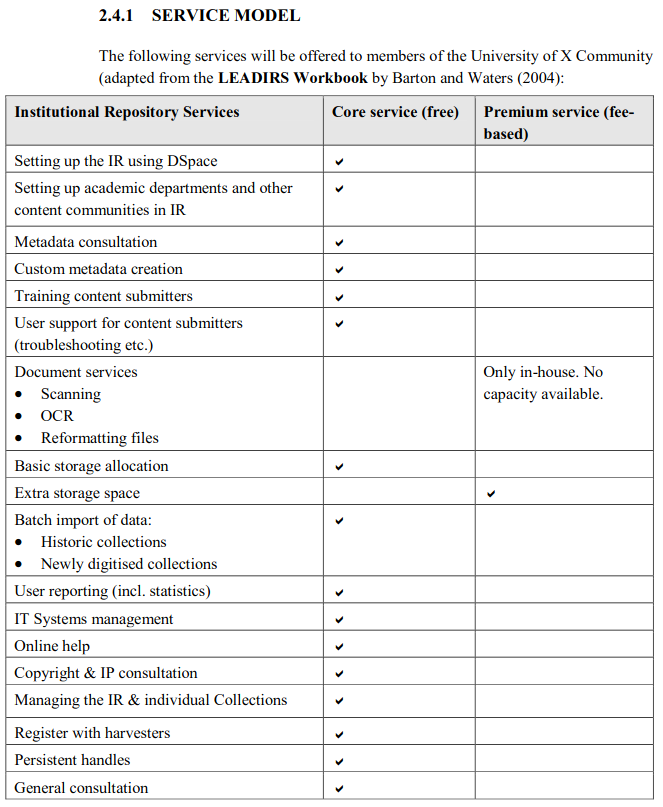
2.4.2 SERVICE DEFINITION
Service Mission
The mission of the institutional repository service will be to:
- Increase the visibility, usage and impact of research by University of X researchers;
- Increase the profile of researchers and the University of X, by help impacting on their H-index, researcher-rating, and finally on the position of the University of X on the Shanghai Jiao Tong University’s list of the world’s top 500 universities;
- Create an institutional leadership role for the library;
- Showcase the university’s research output;
- Capture and preserve all research output by members of the University of X;
- Provide vital services to academics;
- Help other South African libraries to meet the challenges of the digital realm;
- House digitised collections;
- Support the Open Access phenomenon.
Content to be accepted
The primary focus of X will be to collect, organize, preserve and disseminate the research output of the University of X. The supplementary foci will be to collect, organize, preserve and disseminate research output material and to manage such collections.
Primary research output that will be accepted includes:
- Research articles: pre-prints and post-prints
- Conference proceedings
- Chapters in books
- Books
- Theses (Masters)
- Dissertations (Doctoral)
Secondary research output that will be accepted includes:
- Images: Photos/Slides (paper and digital), Art &Cultural Objects, Moving images (animation, movies, videos, TV programmes), Still images (maps, paintings, drawings, plans, zoetropes)
- Sound: Podcasts, Vidcasts, Music, Composer’s work, Interviews
- Special collections (incl. Africana material): Books, Pamphlets, Biographies, Diaries, Letters, Collections
- Technical reports
- Inaugural addresses
- Data sets
- Web articles
- Presentations
- University of X publications
- Events: Exhibitions, Conferences, Open days, Workshops, Open lectures, Seminars
The following will not be accepted:
- Material of administrative or temporarily nature
- Work in progress
- Items protected by copyright, where permission won’t be granted
2.4.3 REPOSITORY STRUCTURE
A sectional structure will be applied, aligned with the structure of the University of X. The content will be presented/organised within different Top-level Communities (i.e. the Faculties), Sub-Communities within the Top-level Communities (i.e. the Departments), and Collections within the Sub-Communities (see 2.4.2 e.g. Research Articles, Theses, Dissertations, etc.)
Example: Faculty of Economic and Management Sciences (Top-level Community)
Department of Accounting (Sub-Community)
Chapters in Books (Collection)
Conference Proceedings (Collection)
Dissertations (Collection)
MARKET ANALYSIS
This set of services will be delivered to the members of the University of X Community.
The University of X Community refers to:
- Present and future staff members of the Library and Information Service, University of X;
- Past, present and future academic staff at the University of X;
- Focus areas, faculties, centers, institutes and research divisions at the University of X.
The key users will be:
- Academics
- Library staff
- Students
- Administrators e.g. Division for Research Development/Research Office
- Internal Research Staff
- External Researchers
The key stakeholders will be:
- Academics
- Library staff
- Students
- Administrators e.g. Division for Research Development/Research Office/Registrars’ Office/Intellectual Property Office/Central IT
- Internal Research Staff
- External Researchers
The following levels of involvement are foreseen by the parties involved:
- Self-archiving of research by departments.
- Digitisation of objects if not available in digital format.
Early adopters that have been identified to run a pilot program are:
- Scholarly publications (i.e. research articles) (All departments)
- Theses and Dissertations (All departments)
It is expected that many additional departments/individuals etc. may become aware of this service offering, and would then be interested in getting involved. These will be accommodated accordingly.
4. STRATEGIC CONTEXT
The development of the library strategy has been aligned with strategic developments on local, national and international levels. The following are important elements of this strategic context:
- The impact of the Internet and IT on the academic environment (http://books.nap.edu/books/030908640X/html/index.html)
- The emphasis on new ways of functioning within the academic information and knowledge environment, e.g. archiving, Open Access/alternative scientific communication, open source software, e-information resources, search engines, digital research, information literacy, knowledge management, cloud computing, new roles for faculty librarians, and the development of academic portals .
- Some national and regional institutions have taken various initiatives in the e-environment. Examples are: (list examples of local repository initiatives).
- The US/CSIR alliance within which the UP Dept of Library Services and the CSIR Information Service have developed an information partnership (SERA).
- The focus on education innovation at the University of X and other SA universities.
- The changing demographic composition of students and staff at the University of X, with accompanied changing IT and information literacy skills.
- The emphasis the new Department of Education funding framework puts on research output by universities.
- The University of X strategic framework.
- The University of X portal as official IT platform using open standards (Java and XML).
5. MARKETING
5.1 POTENTIAL AUDIENCES
This service will initially be marketed to the following:
- Library Management
- Library and Information Service staff
- Faculty Librarians
- Library Catalogers
- University of X Marketing Division
- University of X Division for Research Development/Research Office
- Departments, Centers etc. on campus (Road show)
- Editors-in-chief
- University Management
5.2MARKETING APPROACH: BOTTOM-UP
A bottom-Up approach will be followed when marketing this service to the University of X Community:
- A bottom-Up approach pitches the service to academics, staff, communities that publish on our university website, technical staff in departments, and groups dealing with publications, etc. In this approach, we will prove the need for an institutional repository before requesting support at a higher level.
- Get academics interested in preserving their work for the long-term.
- Tap our Library Advisory Committee to describe to their colleagues the benefits of using an institutional repository.
- Recognize that different departments have different cultures around scholarly communications, different digital needs.
- Look for academic acceptance in a wide range of disciplines, each with different cultures, and different publishing and digital needs.
- Approach academics who have publications on their departmental or faculty websites.
- Meet the editors, webmasters, and content managers on campus and present the service to them. They understand the challenges of online content management and preservation and can be great advocates for institutional repositories.
- Collaborate with other initiatives on campus for online content, e.g. Archives.
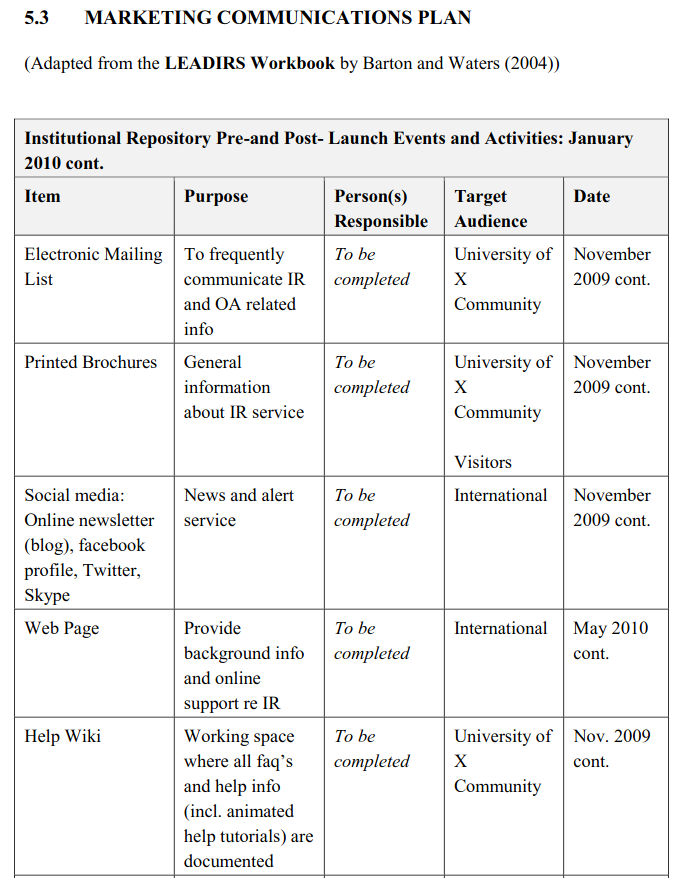
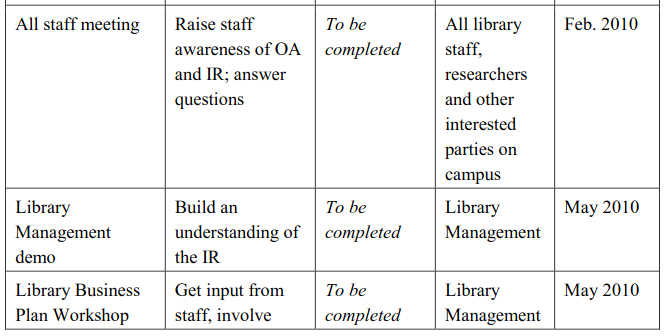
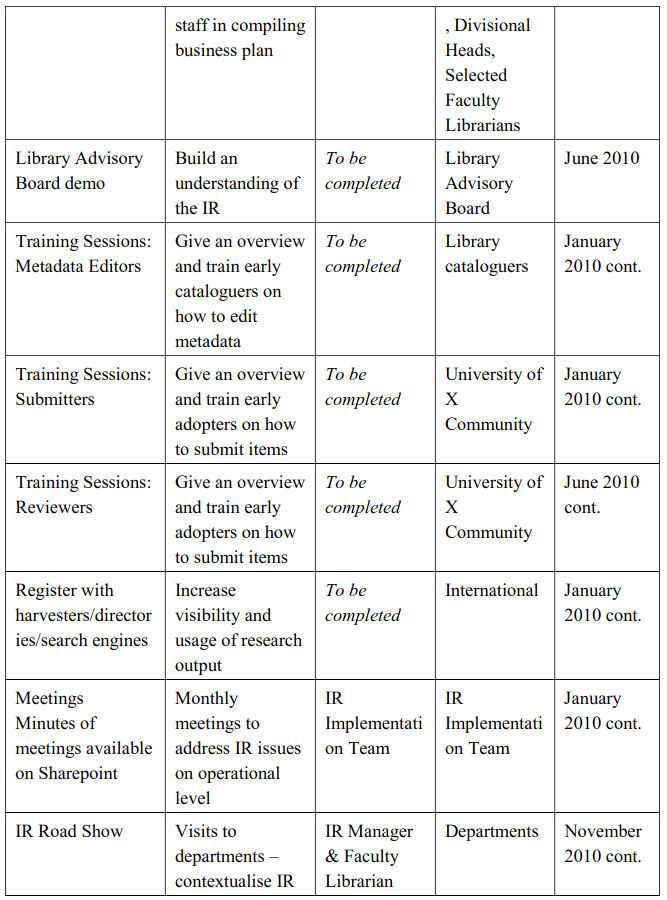
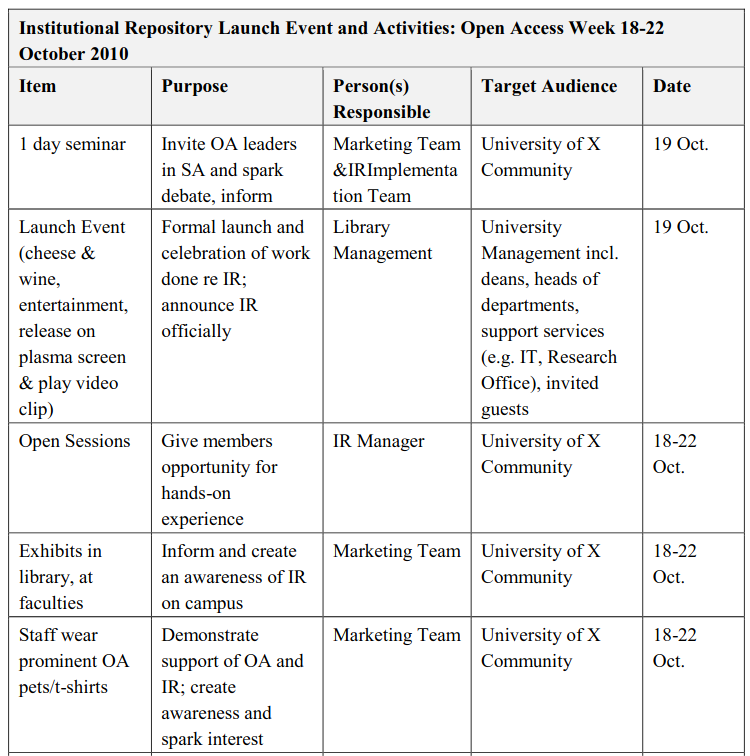
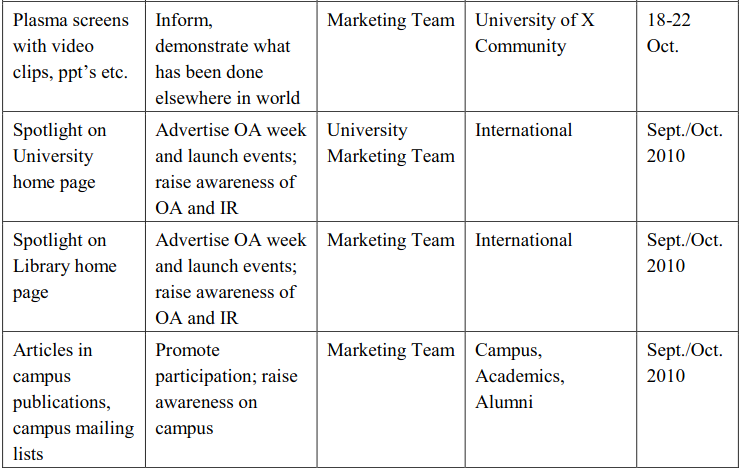
MARKETING BUDGET TO BE COMPLETED
6. MANAGEMENT & STAFFING (CAPACITY PLANNING)
6.1 GOVERNANCE
- The Library Director: Information Technology and Communication is responsible for the successful implementation of the repository (Dr X).
- The Institutional Repository Manager (X) and the Institutional Repository Systems Engineer (X) are responsible for the research, development, implementation & maintenance of the repository system.
- We will rely heavily on existing expertise on campus re digitisation, copyright, intellectual property, metadata and will need to develop expertise where none exists.
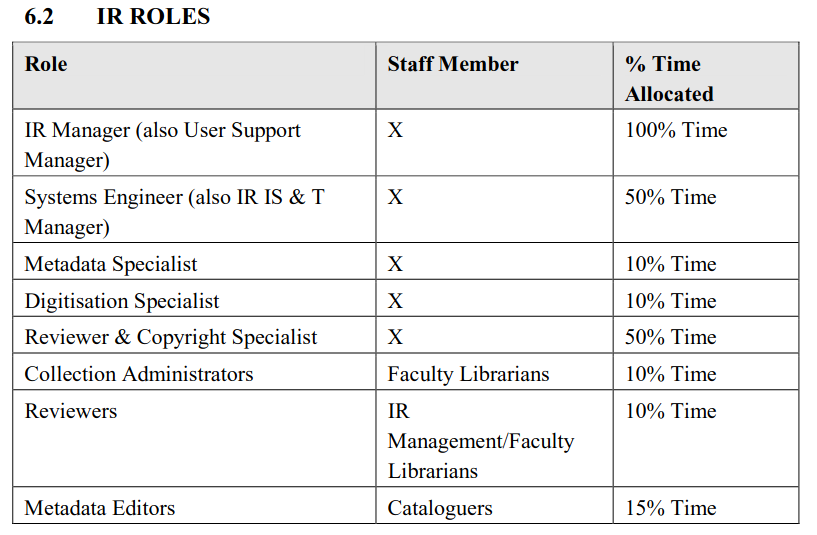
6.3 ROLE DESCRIPTIONS (NOT PART OF FORMAL WORKFLOW)
6.3.1 IR MANAGER (ALSO USER SUPPORT MANAGER)
Reporting to the library’s Director: Information Technology and Communication, the IR Manager has primary responsibility for managing the communication with and support of the institutional repository’s users, and particularly those users adding content to the system. This position requires a knowledgeable, enthusiastic, and self-motivated individual.
Responsibilities:
- Take primary responsibility for all aspects of the system’s user management.
- Perform user training for library staff and content contributors.
- Provide expertise and assistance to the library’s staff in their support of IR end -users.
- Coordinate and manage the definition and setup of new IR content groups, and coordinate and communicate with library subject specialists.
- Perform outreach to university community, including site visits to academics and open and online training sessions.
- Make recommendations on new functionality to IT based on feedback from academics, submitters, and library staff. Plan and implement usability tests.
- Work with marketing and public relations divisions to publicize the institutional repository service.
- Coordinate importing of historical collections with the System Engineer, including collection assessment, metadata consulting, conversion referral, and developing metadata crosswalks if necessary.
- Coordinate digitization activities.
- Compile and provide consultation on policies, as well as issues related to intellectual property and sponsored research as they relate to the institutional repository service. Oversee implementation of these policies.
- Work on projects and teams with library and other groups at university who are closely aligned with IR services (such as the Intellectual Property Office, Research Office etc.).
- Develop marketing material, user documentation, help tools and communicate important information via social media tools and maintain the web site.
Qualifications:
- Postgraduate degree in library science, or equivalent experience.
- Experience with using, and helping others in an academic setting to use web-based software.
- Extensive knowledge of library practices and goals, especially with regard to technology.
- Working knowledge of web-based publishing tools and practices (such as HTML).
- Excellent written and oral communication skills and interpersonal skills.
- Understanding of organizational and library mission and ability to communicate system mission and functionality clearly to key library staff and users at the university.
- Ability to identify opportunities for collaboration and integration.
- Excellent people skills.
Other experience desired:
- Experience supporting complex library systems.
- Knowledge of the university community and research interests.
6.3.2 SYSTEMS ENGINEER (ALSO IR IS & T MANAGER)
To run an institutional repository system you need a technologist who can take primary responsibility for the technology. Reporting to the library’s Head: IT Division, the Systems Engineer has primary responsibility for all aspects of the technical management of the institutional repository. The position requires a knowledgeable, enthusiastic, and self-motivated individual.
Responsibilities:
- Hold primary responsibility for all aspects of the system’s technical management.
- Coordinate related work by the Libraries’ Systems Office and IS staff, including training.
- Contribute bug-fixes and other enhancements to the systems developer if applicable (for open source systems, primarily).
- Perform system monitoring, testing, debugging.
- Provide system administration.
- Monitor and upgrade utility programs and middleware.
- Develop approved system enhancements.
- Perform regular back-up’s (disaster recovery).
- Manage hardware contracts and system administration tasks for IR servers, documenting operational issues.
- Participate in projects and teams working on activities related to the IR service.
- Oversee implementation of IR policies.
Experience :
- Understanding of network (especially web) development issues
- Experience with Unix systems and basic system administration skills
- Ubuntu Linux Server Systems Administration
- Web 2.0 design with XML skills BASH programming skills
- SQL programming skills Java programming skills
- TCP/IP networking skills Familiarity with the LAMP stack
- Familiarity with the Java Tomcat webapp server.
The incumbent should be able to demonstrate at least 2 years experience in all of the above.
Qualifications:
The formal certification would be something with Computer Science or Information Science and helped by any Linux certification.Also see: Capacity Building http://wiki.lib.sun.ac.za/index.php/SUNScholar/Capacity_Building
Other experience desired:
Experience with Open Source development projects and procedures by which source of a project is shared with the community (for open source projects only).
6.3.3 METADATA SPECIALIST
- Share knowledge and expertise on Dublin Core.
- Stay informed on international developments inmetadata.
- Provide metadata training.
- Keep the metadata policy updated.
6.3.4 DIGITISATION SPECIALIST
- Serve as knowledge expert for digitisation issues.
- Provide training.
- Digitise items on request.
- Keep the digitisation policy updated.
- Coordinate digitisation projects.
6.3.5 COPYRIGHT SPECIALIST
- Serve as knowledge expert for copyright issues.
- Provide training.
- Negotiate copyright clearance with copyright owners, and respond to queries from end-users.
6.3.6 COLLECTION ADMINISTRATORS (FACULTY LIBRARIANS)
- Plays an advocacy role and promote the IR amongst researchers.
- Identify possible new Collections, and marketing and training opportunities such as seminars, events etc.
- Liaise with departments for items to be submitted, assistance and support (Submitters).
- Subscribe to departmental Collections, and stay current on material submitted.
- Communicate IR-related issues to departments.
6.4 ROLE DESCRIPTIONS (PART OF FORMAL WORKFLOW)
6.4.1 SUBMITTER (RESEARCHER/FACULTY OFFICIAL/SECRETARY/POSTGRADUATE STUDENT/LIBRARY STAFF)
- Obtain copyright clearance prior to submission, if applicable.
- Digitise item, if applicable.
- Submit full text in the required digital format to the IR.
- Assign basic metadata to describe item as complete as possible.
- Attach full text file/s to item.
6.4.2 REVIEWER (SUBJECT EXPERT/FACULTY LIBRARIAN)
- Review all items submitted to Collection (e-Collection Development).
- Reject if not in line with policy (send explanation), or Approve. Rejection will stop submission.
- Edit baseline metadata.
- Eliminate duplicates.
- Verify quality of full text file/s.
- Provide user guidance.
- Liaise with Metadata Editors on normalization of author name forms.
6.4.3 METADATA EDITOR (LIBRARY CATALOGERS)
- Commit items to archive (repository).
- Can edit metadata of any item at any stage.
- Add LCSH’s to certain items, as identified in the Metadata Policy.
- Add additional metadata where required.
- Conduct a spell check.
- Responsible for final quality check of metadata.
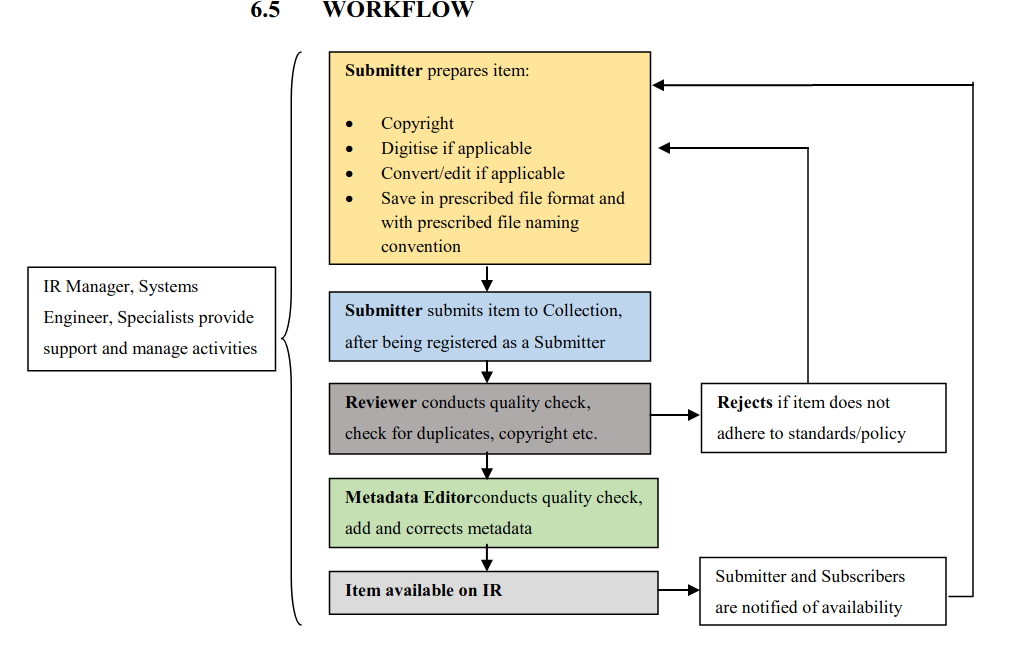
7. PROPOSED BUDGET
Following are some primary and initial budget issues that will be taken into account. To be completed.
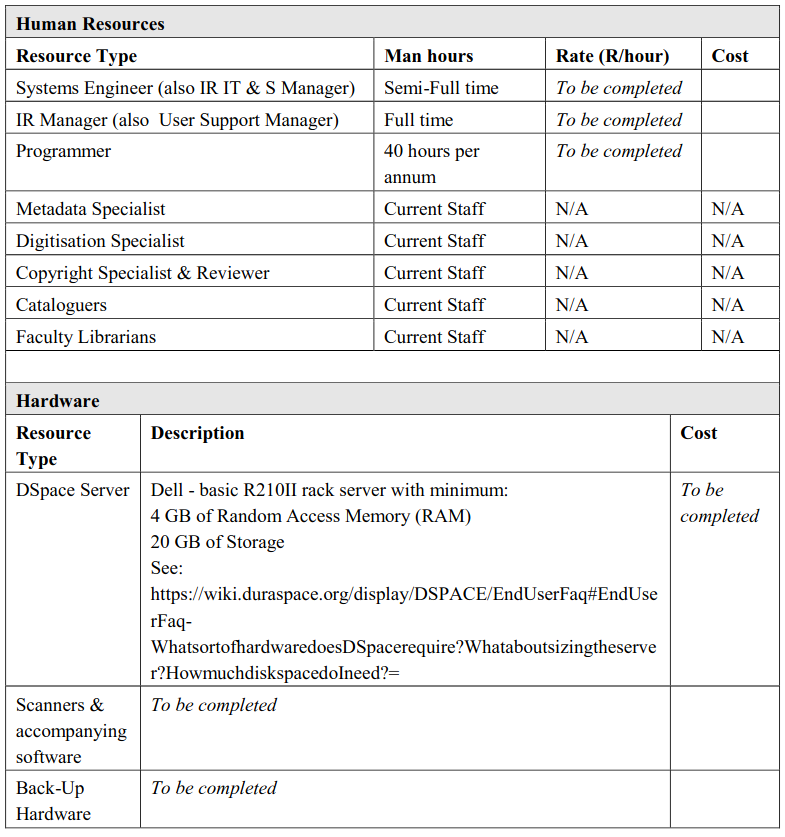
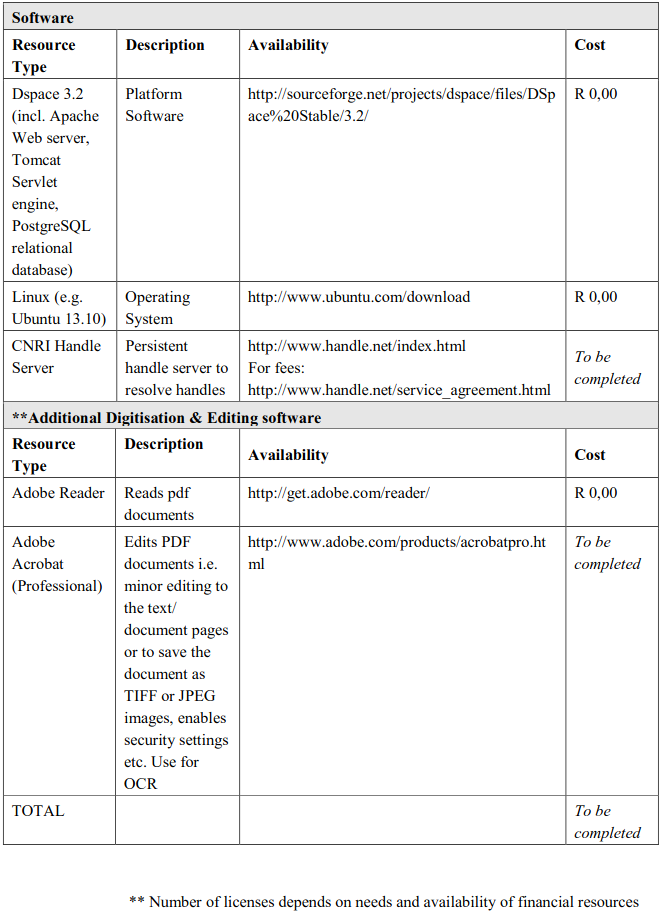
8. RECOMMENDATIONS &IMPLEMENTATION
In order to implement and provide IR services with a reasonable chance of success, staff will be required. In implementing a new system and service, we anticipate the need for considerable effort to fine-tune both the technology and the service component in the first year. In addition, we expect considerable growth in the user base. We believe that trying to accomplish the set goals without dedicated staff would be very risky. If dedicated staff is not assigned, full responsibility for the technical support of the IR will fall to the Libraries’ IS & T Unit, and the responsibility for user support will become the work of the Faculty Librarians throughout the library. While we do expect Faculty Librarians to be involved with users, we believe that relying totally on existing staff in various divisions would be far too fragmented for the launch of a very important new service that needs concentrated attention. In addition, it would seriously compromise other important public services initiatives by drawing away the time of staff members responsible for their planning and implementation. As the IR expands in scope and functionality, management and support efficiencies will have to increase simultaneously. Provision should be made in the library annual budget for developing the IR and additional staff. The following policies will be developed in support of the IR:
- Overall IR Policy
- Digital Preservation Policy
- Digitisation Policy
- Metadata Policy
- Copyright Policy
Close collaboration with various divisions on campus are foreseen, e.g. IT dept., Research Office etc.The IR Implementation Team will be responsible for negotiating further implementation of this business plan. This business plan will then be presented to a broader community for input, after which the final version will be presented to Library Management.
9. BIBLIOGRAPHY
1.Barton, M.R. & Waters, M.M. 2005. Creating an Institutional Repository: LEADIRS Workbook. MIT Libraries.
2.Lynch, C.A. 2003. Institutional repositories: essential infrastructure for scholarship in the digital age. ARL, 226, 1-7. Retrieved January 18, 2007, from http://www.arl.org/newsltr/226/ir.html
3.Sample business plans. http://www.bplans.com
4.Smith, Ina. 2008. University of Pretoria Digital Institutional Research Repository Business Plan
5.Smith, MacKenzie. 2004. Introduction to DSpace.(http://www.nercomp.org/sigs/0304/040609DSpace/060904DSpaceMacKenzie.pdf)
6.University of Leeds. http://www.dpconline.org/docs/DPCTWf4word.pdf
7.Wheatley, Paul. 2004. Institutional Repositories in the context of Digital Preservation
Addendum A: Job descriptions– To be completed
Addendum B: Implementation timeline– To be completed
End of business plan.
